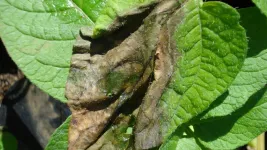(Press-News.org) A new online tool – the first of its kind for plant pathogens – will help researchers across the globe identify, detect and monitor species of Phytophthora, which have been responsible for plant diseases ranging from the devastating 1840s Irish potato famine to sudden oak death that still plagues West Coast oak population.
The new pathogen “tree of life” provides a plethora of information about each of the more than 192 formally described species – including their evolutionary history and relationships within groups – as well as more than 30 other informally described taxa. It also includes genetic sequence data from several locations on the genetic blueprint, or genome, of each species. Other important data include the global locations of each species, the plants that host the pathogen, and where the pathogen resides in – or on – its plant hosts.
“We’re taking all known Phytophthora species and putting them into a living ‘tree of life’ using the Tree-Based Alignment Selector (T-BAS) toolkit that was developed by my colleague Ignazio Carbone,” says Jean Ristaino, William Neal Reynolds Distinguished Professor of Plant Pathology at North Carolina State University and corresponding author of a paper in PLOS ONE that describes the tool. “Researchers can place emerging threat species into the open-access tree and look at which groups are expanding and evolving.”
The new tool will allow researchers to update plant disease information in real time.
“The real key to preventing disease outbreaks is to grab the signals before the outbreak occurs,” said Ristaino, who directs NC State’s Emerging Plant Disease and Global Food Security cluster. “T-BAS could be useful as a tool for disease surveillance and for figuring out the next new lineage that might emerge. Researchers can query this database and the tree will incorporate the new species.”
The first species in the genus Phytophthora, or “plant destroyer,” was described and named in 1876. Phytophthora are present in the air, soil, and water and can cause disease on food crops, ornamental plants, and trees.
“About 150 new Phytophthora species have been identified since 2000,” says NC State Ph.D. student Allison Coomber, who developed the tool with the team.
“This is an unusually large number of plant pathogen species,” Ristaino said. “Many Phytophthora species have broad host ranges, so they can ‘move’ over wider areas.”
Ristaino, who published a paper in Nature in 2001 identifying the strain of Phytophthora infestans that caused the Irish potato famine, hopes to eventually integrate physical maps with the T-BAS data to help provide better pathogen monitoring between states or countries.
“We have mined all published data on Phytophthora,” Ristaino said. “Collaboration and sharing data makes much more sense than being secretive.”
Ristaino added that the Phytophthora T-BAS Tool is housed in the DeCIFR web portal available through NC State’s Center for Integrated Fungal Research, which explores fungi and the roles they play in agricultural, animal, environmental, and human health systems. Further information on access to the tool can be found on the Ristaino Lab website.
Coomber is the paper’s first author. Amanda Saville, manager of the Ristaino lab, and Ignazio Carbone, professor of plant pathology and director of NC State’s Center for Integrated Fungal Research, also co-authored the paper. The work was funded by National Science Foundation National Research Training Grant Award No. 1828820 and by the U.S. Department of Agriculture’s APHIS Plant Protection Act 7721 grants AP21PPQ&ST000020 and AP21PPQ&ST000062.
- kulikowski -
Note to editors: The abstract of the paper follows.
“An open-access T-BAS phylogeny for emerging Phytophthora species”
Authors: Allison Coomber, Amanda Saville, Ignazio Carbone and Jean Beagle Ristaino, NC State University
Published: April 3, 2023 in PLOS ONE
DOI: 10.1371/journal.pone.0283540
Abstract: Phytophthora species cause severe diseases on food, forest, and ornamental crops. Since the genus was described in 1876, it has expanded to comprise over 190 formally described species. There is a need for an open access phylogenetic tool that centralizes diverse streams of sequence data and metadata to facilitate research and identification of Phytophthora species. We used the Tree-Based Alignment Selector Toolkit (T-BAS) to develop a phylogeny of 192 formally described species and 33 informal taxa in the genus Phytophthora using sequences of eight nuclear genes. The phylogenetic tree was inferred using the RAxML maximum likelihood program. A search engine was also developed to identify microsatellite genotypes of P. infestans based on genetic distance to known lineages. The T-BAS tool provides a visualization framework allowing users to place unknown isolates on a curated phylogeny of all Phytophthora species. Critically, the tree can be updated in real-time as new species are described. The tool contains metadata including clade, host species, substrate, sexual characteristics, distribution, and reference literature, which can be visualized on the tree and downloaded for other uses. This phylogenetic resource will allow data sharing among research groups and the database will enable the global Phytophthora community to upload sequences and determine the phylogenetic placement of an isolate within the larger phylogeny and to download sequence data and metadata. The database will be curated by a community of Phytophthora researchers and housed on the T-BAS web portal in the Center for Integrated Fungal Research at NC State. The T-BAS web tool can be leveraged to create similar metadata enhanced phylogenies for other Oomycete, bacterial or fungal pathogens.
END
Alexandria, VA – A symposium to kick off the year-long celebration of the 75th Anniversary of the National Institute of Dental and Craniofacial Research (NIDCR) was featured at the 52nd Annual Meeting & Exhibition of the AADOCR, held in conjunction with the 47th Annual Meeting of the CADR. The AADOCR/CADR Annual Meeting & Exhibition took place at the Oregon Convention Center in Portland on March 15-18, 2023.
The symposium explored a brief history of the founding of NIDCR and its early activities, followed by reflections of the former directors, Harold C. Slavkin, Lawrence A. Tabak and Martha ...
Alexandria, VA – The American Association for Dental, Oral, and Craniofacial Research (AADOCR) has announced the winners of the 2023 AADOCR Hatton Competition. The winners were recognized during the Opening Ceremonies of the 52nd Annual Meeting of the AADOCR, which was held in conjunction with the 47th Annual Meeting of the Canadian Association for Dental Research (CADR), that took place on March 15, 2023.
The Hatton Award was first presented as the "Novice Award" in 1953 and is the oldest IADR/AADOCR ...
Alexandria, VA – The American Association for Dental, Oral, and Craniofacial Research (AADOCR) has announced the winners of the 2023 AADOCR/CADR Joseph Lister Award for New Investigators. The winners were recognized during the Opening Ceremonies of the 52nd Annual Meeting of the AADOCR, which was held in conjunction with the 47th Annual Meeting of the Canadian Association for Dental Research (CADR), that took place on March 15, 2023.
First given in 2018, the AADOCR/CADR Joseph Lister Award for New Investigators is managed by AADOCR and supported by Johnson & Johnson Consumer, Inc. It was created to award young investigators ...
Alexandria, VA – The American Association for Dental, Oral, and Craniofacial Research (AADOCR) has announced the winners of the 2023 Student Competition for Advancing Dental Research Application (SCADA). The winners were recognized during the Opening Ceremonies of the 52nd Annual Meeting of the AADOCR, which was held in conjunction with the 47th Annual Meeting of the Canadian Association for Dental Research (CADR), that took place on March 15, 2023.
In 2017, AADOCR and Dentsply Sirona joined forces to co-sponsor SCADA, which was previously known as the Student Clinicians of ...
Wearable devices such as smart watches could be used to detect a higher risk of developing heart failure and irregular heart rhythms in later life, suggests a new study led by UCL researchers.
The peer-reviewed study, published in The European Heart Journal – Digital Health, looked at data from 83,000 people who had undergone a 15-second electrocardiogram (ECG) comparable to the kind carried out using smart watches and phone devices.
The researchers identified ECG recordings containing extra heart beats which are usually benign but, if they occur frequently, are linked to conditions such as heart failure and arrhythmia ...
Cold activates a cellular cleansing mechanism that breaks down harmful protein aggregations responsible for various diseases associated with aging. In recent years, studies on different model organisms have already shown that life expectancy increases significantly when body temperature is lowered. However, precisely how this works has still been unclear in many areas. A research team at the University of Cologne’s CECAD Cluster of Excellence in Aging Research has now unlocked one responsible mechanism. The study ‘Cold ...
A very subtle and seemingly random type of eye movement called ocular drift can be influenced by prior knowledge of the expected visual target, suggesting a surprising level of cognitive control over the eyes, according to a study led by Weill Cornell Medicine neuroscientists.
The discovery, described Apr. 3 in Current Biology, adds to the scientific understanding of how vision—far from being a mere absorption of incoming signals from the retina—is controlled and directed by cognitive processes.
“These ...
UTICA, NY –A $71,000 donation by the Griffin Charitable Foundation, based in Rome, New York, was awarded to the Masonic Medical Research Institute (MMRI) to purchase a new state-of-the-art microscope for imaging cells. “It came as wonderful news that the Foundation pledged this generous donation,” said Stephen F. Izzo, MMRI’s Development Director. “This gift will make a profound impact on our research capabilities.”
The Griffin Charitable Foundation supports not-for-profit entities serving Rome and select organizations ...
AURORA, Colo. (April 3, 2023) – A study published in Frontiers in Surgery finds that people with schizophrenia (SZ) and schizoaffective disorder (SAD) have overall lower surgical risk than people with Parkinson’s disease, which is reassuring when considering potential surgical interventions such as Deep Brain Stimulation (DBS) for the treatment of SZ and SAD.
DBS, a procedure that implants electrodes in the deeper structures of the brain connected to generators in the chest, is rare in treating SZ and ...
HOUSTON – (April 3, 2023) – Missing crucial doses of medicines and vaccines could become a thing of the past thanks to Rice University bioengineers’ next-level technology for making time-released drugs.
“This is a huge problem in the treatment of chronic disease,” said Kevin McHugh, corresponding author of a study about the technology published online in Advanced Materials. “It’s estimated that 50% of people don't take their medications correctly. With this, you’d give them one shot, and they’d be all set for the next couple of months.”
When patients fail to take prescription medicine or take it incorrectly, the costs can ...



